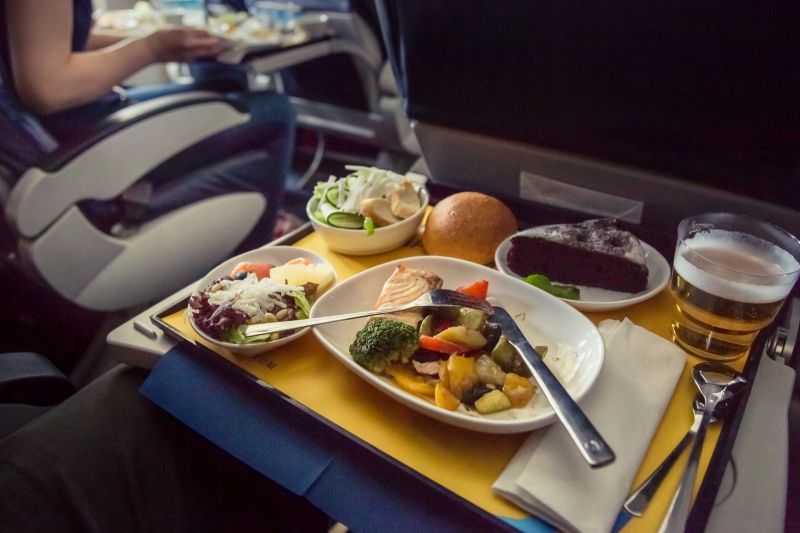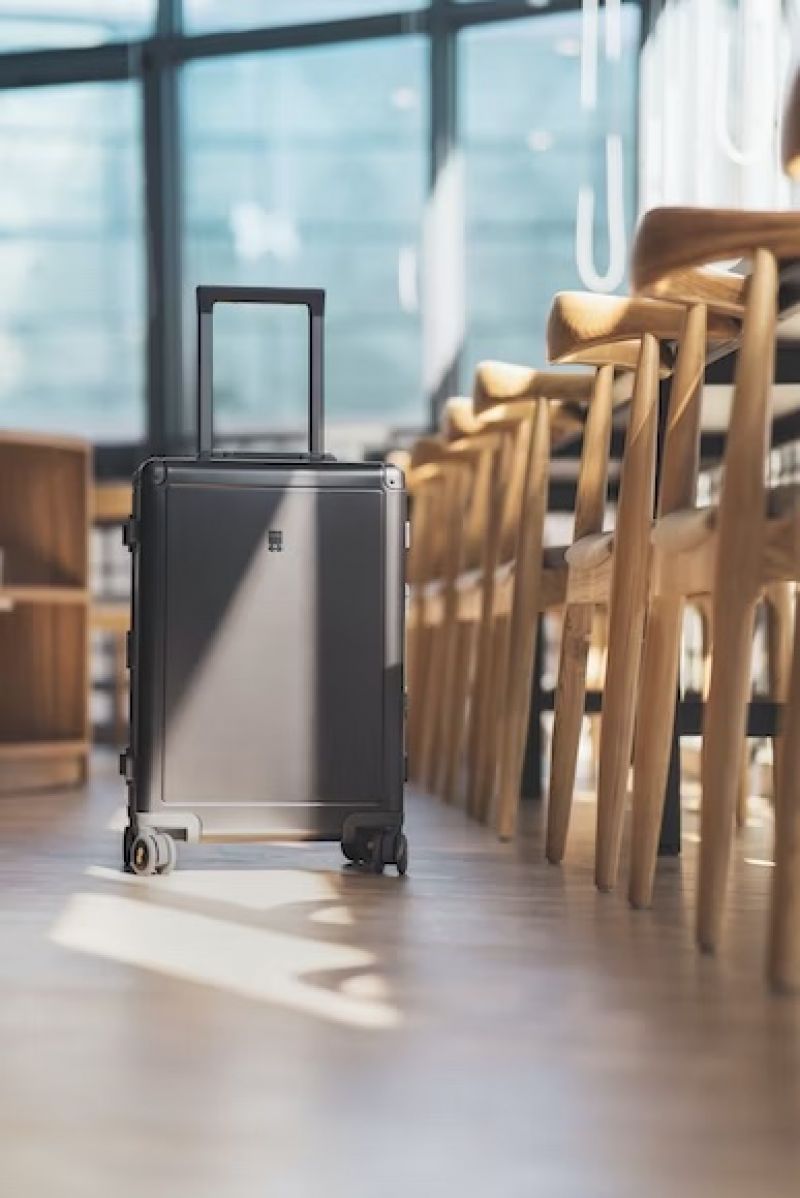If I bring sealed "sandwich crackers" or granola bars, purchased in the U.S. on a Caribbean cruise (but not eaten or opened during the trip), do I need to declare them as a food product when re-entering at the cruise terminal? The issue has never come up in many years of cruising, but after watching some of the "Smugglers" shows on TV, I'm wondering if this could be a problem. Don't want to pay a big fine for a granola bar!

Foods You Can Bring Through Airport Security - The Complete Guide
It’s getting harder and harder to keep track of all the regulations relating to air travel these days. From Covid-19 restrictions to more stringent airport security procedures, it’s important to make sure you don’t fall foul of the rules.
One of the main issues currently is whether or not you can bring food through TSA-administered checkpoints. Part of the Department of Homeland Security, the TSA (Transportation Security Administration) oversees security through US-based and US-connecting transportation hubs, and they play by their own rules sometimes.
While many airports use standard guidelines to dictate what you can and can’t take through security, if you’re planning on traveling to the US or even connecting through a US airport, you should know exactly what you’re in for. Plus, it’s also helpful to know the worst airports in the US for delays to avoid surprises.
Let’s answer the question of whether you can bring food through airport security.

General TSA Food Rules
A good rule of thumb when it comes to packing food in your carry-on luggage is that solids are usually fine, and liquids, spreadables, or gels are also permitted but cannot exceed 3.4 oz. The TSA calls it the 3-1-1 rule, allowing 3.4 oz or 100 ml of these items that all must be contained in one quart-size clear plastic bag.
How to bring liquid or spreadable items through security checkpoints
When deciding what to bring on a plane, measure, measure, measure. Anything that’s a liquid, gel, or spreadable is subject to the 3.4 oz rule. Before your trip, purchase some TSA-approved 3.4 oz containers that are clearly marked and prioritize what you actually need.
Just because you’ve packed or poured everything into appropriately-sized containers doesn’t mean you won’t run into trouble. Even the 3.4 oz containers have a limitation. Each passenger is allowed one quart-sized clear plastic bag in which to put their liquids and gels. This amounts to roughly 9 containers. So don’t go crazy!
Overview Table of Permitted Through TSA
You may be curious about specific food categories, so here is an overview table to further clarify if you can take food through TSA security checkpoints:
Food Item | Permitted Through TSA | Permitted in |
Alcoholic Beverages | Yes, up to 3.4 oz per container | Yes |
Alcoholic Beverages | No | No |
Baby Food, Baby Formula, | Yes, in reasonable quantities | Yes |
Bottled Water | Yes, up to 3.4 oz per container | Yes |
Bread, Pizza, | Yes | Yes |
Candy | Yes | Yes |
Canned Foods | Yes, but if not solid, can must be | Yes |
Spices and Powders | Yes, but powder-like substances | Yes |
Cereal | Yes | Yes |
Creamy or Liquid Cheese | Yes, up to 3.4 oz per container | Yes |
Solid Cheese | Yes | Yes |
Crackers | Yes | Yes |
Meat and Seafood | Yes, for domestic flights | Yes, for domestic |
Fruits and Vegetables | Yes, for domestic flights | Yes, for domestic |
Ice and Ice Packs | Yes, as long as frozen solid | Yes |
Sorting through your passenger rights is a lot like sorting through the TSA food guidelines. Eliminate the confusion and contact AirAdvisor if you encounter a flight disruption.Check Your Flight
What kind of food can you take through the TSA?
To elaborate on the table above, generally speaking, as long as you stick to the 3.4 oz rule for liquids, gels, and spreadable foods, you should be ok. Even your bottle of water has to be less than 3.4 oz, so bring a refillable one instead and fill it up once you clear security. Here are some other situations to be aware of.
Open Food
The TSA typically doesn’t care whether your food containers are open or not. What they do care about, though, is if your food is solid or not. Open foods are subject to the standard 3.4 oz rule, but otherwise, homemade bread, last night’s leftovers, or an open bag of chips are all allowed by the TSA.
Frozen Foods
Like open food, the TSA doesn’t put any limitation on the amount of frozen food you pack, but it has to be frozen solid when going through security. Otherwise, you’ll be in violation of the liquids/gels policy.
If you’re planning to travel with meat or seafood, they are permitted in your carry-on, but if you’re packing ice to keep the food cold, the ice packs have to be frozen solid at the time of your security screening. Dry ice is a good alternative to conventional ice packs and is allowed in quantities smaller than 5.5 pounds. Additionally, if you’re returning to the US from an international destination, any meat or seafood products must be declared and are subject to inspection. Whether they’re even allowed or not depends on their origin, but most are not.

Baby Food
Luckily, the TSA understands that baby food, breast milk, and formula are important, so it’s not subject to the same 3.4 oz limitations as other liquids. There is no hard and fast rule as it’s up to the discretion of the TSA agent, but reasonable quantities for the duration of your travel period are permitted. Make sure you separate your baby food from the rest of your items so that the TSA can inspect it properly, and let them know what you have before starting the screening process.
This also applies to toddler drinks and toddler food like puree pouches. They don’t need to be in 3.4 oz containers or fit into a quart-sized clear plastic bag.
Alcohol
When it comes to the TSA, alcohol is treated the same as any other liquid and must be in 3.4 oz bottles that fit into a quart-sized plastic bag. The exception is if you’re planning to transport alcohol that’s over 140 proof (70%). This type of alcohol isn’t even allowed in your checked bag, so leave it at home.
Fruits and Vegetables
When flying domestically within the continental US, fresh fruits and vegetables are permitted in their natural state. As long as your fruits or veggies haven’t been turned into a liquid or gel, you won’t have to comply with the ever-present 3.4 oz rule.
Bringing fruits and vegetables through the TSA from Hawaii, Puerto Rico, or any other US territory is generally prohibited due to the risk of importing invasive species to the mainland US. The same goes for produce brought back from international destinations.
Foods to Pack - TSA-Approved Meals to Pack in Your Carry-on
You can’t always rely on a tasty meal onboard, although some airlines have better food than others. It is safest to bring your own, and when you can’t be bothered worrying about using 3.4 oz containers for your onboard meals and snacks, you won’t go hungry. Food planning is easy as long as you know the rules, and it’s always smart to have a little extra available in case your flight is delayed or even canceled entirely.
Disrupted flight? You might have a right to compensation - up to $650.Check Your Flight
Ideal Snacks Approved by the TSA
If your flight isn’t particularly long, you can likely get away with just packing a few snacks to curb the hunger pangs. Here are some ideas for snacks you can take through TSA screenings:
- Solid foods like cereals, granola bars, chips, popcorn, chocolate, and crackers.
- Dried fruit. Fresh fruit is also fine as long as you are flying domestically within the continental US.
- Hard cheese to go with the crackers.
- Protein bars for energy.
Meals Ideas Approved by the TSA
Ultra long-distance flights are not uncommon these days, so when you need something more substantial, consider dining on the following:
- Sandwiches or wraps. Domestic continental US passengers can also add whatever veggies and meat they want to the meal.
- Salads. Grain-based salads are especially filling, or a healthy green salad would pass TSA scrutiny as well, as long as you’re flying with the continental US. If you need salad dressing, though, be prepared to carry an extra 3.4 oz container of it. Or better yet, mix your salad right before you go through security to preserve freshness.
- Charcuterie. Stick to hard cheeses, and you’ll be ok.
Have you experienced a flight delay? You could be entitled to up to $650 in compensation.Check Your Flight
Foods You Can't Pack in Your Carry-on - Banned on Airplanes
As we’ve seen, you can bring food through TSA checkpoints, subject to a few rules. But there are a few things that will usually be prohibited. These include:
- Alcohol over 140 proof. It also isn’t permitted in your checked luggage.
- Canned goods. Canned goods are usually banned because they contain liquid and exceed the 3.4 oz limitation. This pertains to things like canned chili, soup, or sauces. Pack them in your checked baggage to save yourself the trouble. If you really have to have the can’s contents with you, decant it into a 3.4 oz bottle or jar.
- Thawed ice packs. If you’re transporting fresh foods that need to be kept cold, use dry ice or make absolutely sure that the ice packs are frozen solid when you go through security. Otherwise, they’ll be confiscated, and your food will spoil.
- Creamy or soft cheeses. It may surprise you to learn that for TSA purposes, creamy cheeses are considered liquids, so your delicious brie or camembert better be less than 3.4 oz and packaged accordingly. Sadly, cheesecake is also included in this category.
Flights from outside the U.S.
When you’re flying within or outside the US, flights can be delayed at any point, and some flights are more likely to be delayed or canceled than others. Aside from this, flights from outside the US are subject to the same limitations as domestic travelers, with a couple of extra exceptions. These exceptions are predominantly related to entering the US with fresh fruits, vegetables, meat, or seafood. This includes anything with the aforementioned products in it as well.
Generally speaking, fresh produce and other agricultural items are not allowed to be imported into the US. This is due to the potential risk of importing pests and other contaminants into the country. Your best bet is to leave these things behind, and if you do bring anything like this, make sure you declare it, knowing it will likely be subject to an inspection and eventual confiscation or disposal.

Tips to Take Food Through Airport Security
As long as you’ve at least thought about the question of can you bring food through the TSA, you’re ahead of the game. Stick to 3.4 oz containers for anything liquid, gel, or spreadable, and you’ll be fine. Remember the 3-1-1 rule, which means you can have 3.4 oz or 100 ml in one quart-sized clear plastic bag.
Be extra careful when you’re packing, and don’t throw anything in without pondering the 3-1-1 rule. This will make your TSA screening much quicker, and they always prefer that you’re upfront about exactly what you have.
Bring an empty refillable water bottle with you and a few extra 3.4 oz containers in case you unexpectedly need to decant a liquid. Make sure anything perishable is properly cooled, ideally using dry ice, and pack enough meals and snacks to keep you going even in the event of an extensive flight disruption.
It’s also good to know that passengers can check compensation for a delayed flight (or even a canceled one) to recoup some costs, hopefully, but this compensation won’t magically unspoil the expensive steaks or fancy cheese you were transporting.
To keep everything straight, check out this cheat sheet:
Item | Guidelines |
Ice Packs | Must be completely frozen |
Meat/Seafood | Permitted for domestic travelers, |
Fruits/Vegetables | Permitted for domestic travelers, |
140-proof Alcohol | Leave it behind |
Creamy Cheese | 3.4 oz containers or less |
Solid Snacks | Always permitted, avoid meat |
Liquid/Gel/Spreadable | 3.4 oz containers |
Open Food | Always permitted, avoid meat, |
Baby & Toddler Food | Permitted within reasonable |
If you packed extra food in case your flight was canceled and it was, know your rights and claim your refund.Check Your Flight
Conclusion
It can seem daunting to navigate the rules surrounding the question, “Can you bring food through the TSA?” but a little planning and research goes a long way. Stick to solid meals and snacks for your onboard foods, and if you’re bringing food-related gifts for friends and family, stick to exclusively solid items.
As you pack for your flight, use our handy cheat sheets to make sure you aren’t breaking any rules. Plus, remember that foods aren’t the only items prohibited in carry-on luggage. Following all the guidelines should result in a seamless trip through TSA security. And when in doubt, have lots of 3.4 oz (or 100 ml) containers on hand. In fact, bring an empty one with you because you never know when you might need it!
FAQ
Which foods are prohibited by the TSA?
Foods in liquid, gel, or spreadable form are prohibited if they exceed the 3.4 oz limit. This includes things like peanut butter, honey, creamy cheese or cheese in liquid, olive oil, and dips. Additionally, although alcohol is permitted in 3.4 oz containers, 140 proof (70%) alcohol is not.
Can I take snacks through airport security?
Absolutely. There’s no need to starve on the plane or buy expensive airport snacks. Pack any solid food you like with no limitations - granola bars, nuts, chips, and crackers all make excellent plane snacks. If your preferred snack is spreadable, like peanut butter, a liquid, or a gel, just ensure it fits into a 3.4 oz container.
Can I bring biscuits through airport security?
Biscuits or cookies as gifts or as your snack on the plane are generally accepted through security by the TSA. That said, just make sure they don’t contain any liquid or gel-like icing or filling.
What about cheesecake? It’s not a liquid!
While it’s true that cheesecake doesn’t fit into the category of liquid or gel, it would be considered a soft cheese and technically spreadable. So, it’s only permitted in 3.4 oz bags or jars. Squishing a piece of cheesecake into a small container will probably ruin it, so eat it before you get to the airport.
Can I bring crisps through airport security?
Definitely. Crisps (or chips) are a great security-friendly food that doesn’t trigger any of the special TSA rules. In fact, they are one of the best portable snacks for plane travel.
Can I bring alcohol onto the plane?
The good news is yes, you can. Subject to the 3.4 oz container limitation, any alcohol that is less than 140 proof (70%) is allowed through the TSA. If you’re planning to consume it on board, check with your airline’s specific rules to avoid disappointment.
Can I take sealed food or canned food through airport security?
Technically, both sealed and canned foods are permitted items according to the TSA. But, most canned goods contain liquids and are larger than 3.4 oz. If that’s the case, put the can in your checked baggage or prepare to decant it into smaller containers. If it’s over 3.4 oz and contains liquid, gels, or spreads, it won’t be allowed in carry-on bags, regardless of if it’s sealed or in a can.
Can I take homemade food through airport security?
Yes, as long as it honors the 3-1-1 rule. Liquids, gels, and spreadable items must be placed in 3.4 oz (100 ml) containers. If the food is completely solid, it’s fine. Just watch out for liquid centers, soft cheeses, and in the case of international travelers, meat and seafood or fruits and vegetables contained in the homemade foods.
Can I take fresh food on the plane?
Fresh food like fruit, vegetables, and meat products are permitted through security as long as you’re flying within the continental US. These items are not allowed if brought into the US from an international destination or from US territories, Hawaii, or Puerto Rico.
What if I need to bring food for my baby?
Don’t panic. Both baby and toddler food, including breast milk, formula, and pureed food, are not subject to the TSA’s 3-1-1 rule. Travel with reasonable amounts, and you’ll have no problem getting these necessary items through the security screening.
Leave your feedback
We don’t spam.


